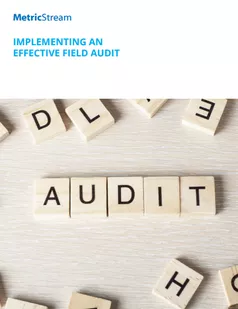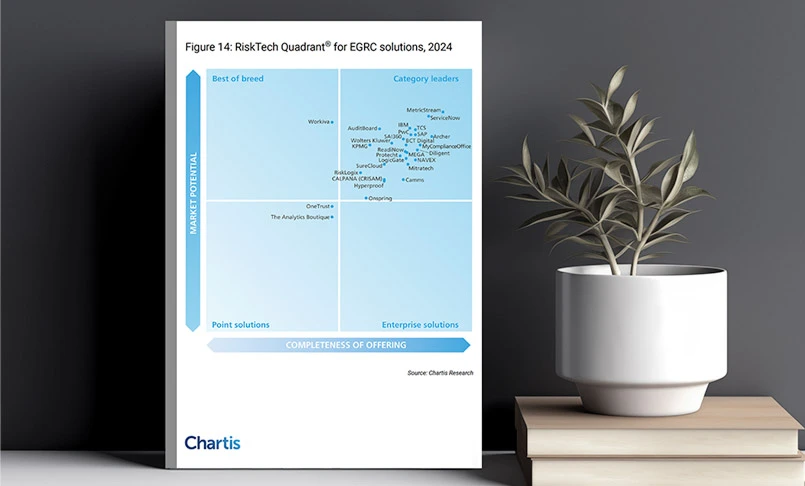ConnectedGRC
Drive a Connected GRC Program for Improved Agility, Performance, and Resilience
-
BusinessGRC
Power Business Performance and Resilience
Discover ConnectedGRC Solutions for Enterprise and Operational Resilience
Explore What Makes MetricStream the Right Choice for Our Customers
Discover How Our Collaborative Partnerships Drive Innovation and Success
- Want to become a Partner?
Find Everything You Need to Build Your GRC Journey and Thrive on Risk
Learn about our mission, vision, and core values
How to Implement an Effective Field Audit?
Overview
A well-designed field audit can provide a wealth of insights to strengthen business performance at organizations. However, each audit is only as good as the processes, people, and technology involved. With that in mind, here are four recommendations to strengthen your field audit.

Field audits play a key role in identifying and reducing quality issues, minimizing safety incidents, preventing inventory losses, and providing closed-loop feedback for continuous improvement. These audits are conducted extensively in organizations across industries, including retail, consumer goods, logistics, manufacturing, healthcare, hi-tech, and energy and utilities. However, the audit processes are often conducted manually, using cumbersome photocopied questionnaires and checklists or multiple spreadsheets to enter data. The information gathered is then manually sent to the corporate audit team, who summarizes and distributes the findings and reports to management.
This approach may provide the basic audit data. However, it is both time-consuming and resource-intensive. Moreover, it doesn’t enable a deep-dive analysis of the root cause of audit scores and findings, as the information that is reported is relatively static. In other words, organizations may not get an accurate and real-time picture of their risks and issues which, in turn, limits their ability to improve quality and customer satisfaction.
Does this use case scenario sound familiar? If so, it might be time to rethink your current approach to field audit management, and instead shift to a faster, simpler, and more high-performing approach.
Requirements for a Well-designed Field Audit
In talking to our customers and industry analysts, we believe that a well-designed field audit program must achieve the following at minimum:
- Provide immediate access to all field audit data at any level, across the extended enterprise (corporate, franchisees, suppliers, etc.)
- Establish an audit database across all field locations to enable real-time and historical data analysis, trend analysis, and root cause analysis on inventory losses, as well as safety and quality incidents
- Automate and streamline field audit data management processes to minimize errors
- Enable field auditors to distribute their findings to managers and executives in a swift and easy manner
- Allow field auditors to review audit scores interactively with personnel, and help raise these scores through training and continuous improvement programs
Next-Gen Mobile Auditing
Laptops or desktop systems can be cumbersome tools for field auditors who often have to move around in places with intermittent or no network connectivity. As a result, organizations are increasingly adopting offline and mobile auditing solutions that enable auditors to conduct field work on the go, without having to reenter their data when they return to the office.
Four Recommendations for Your Field Audit
A well-designed field audit can provide a wealth of insights to strengthen business performance at organizations. However, each audit is only as good as the processes, people, and technology involved. With that in mind, here are four recommendations to strengthen your field audit:
1. Automation and Integration
Save time and costs by finding a way to automate your field audit workflows. Auditors should ideally be free to focus on important processes such as analyses of findings and issues, rather than tiresome data entry and formatting tasks. Integration of field audits with other processes in the audit lifecycle is also important. Many organizations are adopting a centralized system to manage the entire audit lifecycle, thereby ensuring better consistency, control over, and visibility into audit processes and data.
Questions to consider
- What areas of your field audit can be automated?
- Are audit results tightly integrated with corrective action and preventive action plans?
- Are audit scorecard workflows triggering a well-integrated training program to raise the performance of under-performing units?
- Can your audit solution be integrated with other systems such as risk and compliance management solutions?
2. Mobility
Mobile audits simplify and expedite audit processes and field work by doing away with papers and spreadsheets. Field auditors have the flexibility to enter data anytime and anywhere, while also capturing images and videos via camera-enabled tablets. These files can be used to support evidence of audit findings. Meanwhile, GPS-enabled mobile audit devices can capture the geospatial co-ordinates of the field location, thus improving the accuracy of audit data. If there is no network connectivity in the field, offline audit capabilities can help auditors enter and save their data as they usually do, and later synch the findings with the central audit database.
Questions to consider
- How can you effectively use hand-held devices like smart phones and tablets to improve audit efficiency?
- Are these mobile devices easy to use and practical?
- Can the audit findings and data be automatically integrated with the centralized audit database?
- Are there built-in rules to check for data integrity at the point where auditors capture findings in the field?
- Does the mobile audit device hold audit data even when network connections are lost?
3. Real-time Visibility
Maintaining all audit work papers in a single point of reference makes it easy and convenient for field auditors to manage, store, access, download, and assign these documents. Similarly, with multiple field audits taking place at different locations across the enterprise, it is important to have a centralized and real-time picture of each field audit. Audit managers need to be able to monitor the progress of the audit against pre-defined milestones in order to ensure that each activity is on track. Quick audit reporting is essential as well - field auditors must be able to compile and report their findings as quickly as possible in both draft and final report form to enable informed decision-making.
Questions to consider
- Are all your audit documents and work papers easily accessible to field auditors?
- Does management have the ability to slice and dice audit findings from various perspectives, and drill down into specific issues to understand their root cause?
- Can audit trends and patterns be drawn out of the audit data using analytics?
- Can your field audit activities be monitored in real time?
4. Agility, Adaptability, and Auditability
A well-designed audit program must be auditable in itself to ensure that the program is running as you expect. Agility and adaptability are other critical factors. Implement audit methodologies and systems that can adapt to, evolve, and scale up with your business processes and objectives. New stores, new processes, or future mergers and acquisitions will dictate that your audit methodology change over time.
Questions to consider
- Can you set up audits for your auditors?
- Do your field auditors believe that management and reviewers have full visibility into their data and results?
- Can the audit scoring methodology be easily refined as you get more insights into your processes and business?
- Can you enhance or build new audit applications over time?
Conclusion
At a time when businesses are rapidly expanding, and new risks and compliance requirements are constantly emerging, it is critical to get real-time, on-the-ground insights into your operations. Experienced field auditors play an essential part in spotting key risks and issues, leading to proactive performance improvements. However, they also need effective processes and systems. Automated, agile, and mobile-enabled audit workflows, coupled with powerful data management and reporting tools, can not only help field auditors improve their productivity and efficiency, but also enable a deeper, more sophisticated analysis of audit findings.

Subscribe for Latest Updates
Subscribe Now






